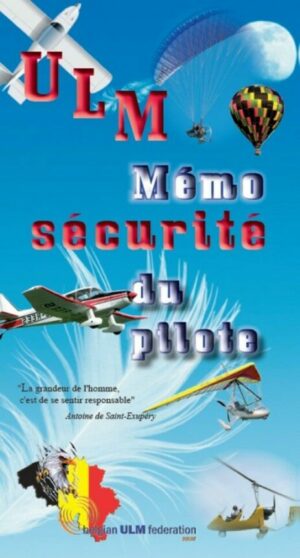The Belgian Microlight Federation
The Belgian ULM Federation is an interest group of microlight pilots and microlight owners aiming to promote and support microlight air sports.
Flight Preparation

Preparing for a flight.
You need to keep abreast of European (SERA) and national (AIP) regulations in the countries you visit. You need to know which airfields and runways are accessible to microlights. You need up-to-date aeronautical charts (ICAO or other charts).
You also need to prepare for a flight in the short term: in addition to the AIPs, you need to consult
- the SUP AIPs in force on the days and places of the flight,
- the NOTAMs on the route and those relating to the runways visited
- military activities (if any)
- the weather and ephemeris for the outward and return journeys
And don’t forget the flight plan, if required by the type of flight you’re doing… and a microlight in perfect flying condition!
Flying Abroad

The level of technical sophistication and operating costs of recent microlights means that you can dream and travel. However, crossing borders can sometimes be administratively tedious, as each European country has its own rules and regulations. In the ULM world, nothing is standardised in Europe and the rules are not governed by ICAO regulations. There are major variations between countries, such as medical requirements for pilots, maximum flying heights, maximum machine weight, overflight authorisations, etc.
It is therefore essential to consult the regulations specific to each country you cross and visit.
Good places to start your preparations:
- the European Microlight Federation (EMF) website, which provides a compilation of the various European requirements. See here
https://emf.aero/mla-flying-in-europe/
- the AIPs of the countries concerned, starting with GEN 1.2 (entry to and exit from airfields) and continuing your preparations according to the specific data; the list of sites giving the national AIPs can be found here
https://www.eurocontrol.int/articles/ais-online
The more documents you have in English (insurance, registration certificate, etc.), the better.
Mountain Flying

Flying safely in the mountains requires specific and demanding piloting skills, as well as a responsible attitude. It can’t be improvised.
To find out more, please consult the detailed document by clicking on the following link:
Flying over the sea

Water overflight is defined as a flight which is at such a distance from the coast that, in the event of a breakdown, the aircraft cannot reach land suitable for an emergency landing.
At a distance of more than 50 nm from the coast or more than 30 minutes over the sea at cruising speed, it becomes compulsory to carry special equipment: life jackets, beacons, lights or mirrors to send distress signals. In this case, the flight plan is compulsory, as is a cruising altitude enabling permanent radio contact to be maintained.
There are a few tips to anticipate and prevent the possibility of a breakdown: take care with pre-flight checks, fly as high as possible, keep a boat in sight as far as possible, prevent carburettor icing if you are flying in a damp atmosphere, by regularly testing for the presence of ice using the carburettor heater if you have one.
In the event of ditching, remember that this is one of the emergency procedures in light aircraft with the highest survival rate. For example, in the event of an engine failure near a coastline, it is preferable to attempt a water landing rather than a landing on inhospitable terrain (mountain, forest, etc.).
Below is a link to a document produced by the DGAC. It sets out very clearly the procedures to follow in the event of a ditching: managing the aircraft’s trajectory, the approach, the impact, the evacuation and the organisation of survival.
Flying with a passenger

Taking along a passenger means sharing the pleasure and passion of flying with them, letting them discover new sensations and magnificent landscapes from new angles, but it’s also a great responsibility for the pilot. So taking on a passenger is not something you can do without preparation.
Draw up a checklist for this purpose and take the time to explain to your passenger what you are going to do with him. Help them to board, give them a few explanations about the various on-board instruments, encourage them to keep an eye out during the flight and let you know if they spot any other traffic, remind them to keep quiet during radio exchanges, demand that they let you concentrate during the take-off and landing phases, check that they feel at ease during the flight and don’t hesitate to shorten the flight if necessary. Watch out for camera straps or bags that could interfere with the flight controls… not forgetting the instructions to follow in the event of an emergency landing. Don’t forget to ask for parental permission if you are taking a minor on a flight.
Check the Weather

This stage is essential, and is not limited to assessing the weather at the place and time of departure. Weather conditions can change dramatically over the course of a few hours and on different routes.
As well as the national weather sites, there are many other sites worth checking out: WeatherPro, Meteo Blue, Ventusky, Windy, MeteoX, MeteoNews etc . Don’t hesitate to cross-check the weather information on different sites, as they don’t always agree on the forecasts, even in the short term. Visibility, cloud base, cloudiness, wind and precipitation are the 5 elements to take into account. Consulting the Taf and Metar is far from enough!
You should also be aware of weather conditions that are conducive to icing (fog, relative humidity, temperature and dew point), as well as extreme heat, particularly at high altitudes.
Safety Leaflet

BULMF regularly publishes a safety memo, which is a good basic document (a must-have, one might even say) dealing with the subject of safety in microlights.
The Fédération Française de l’ULM has also published a well-written safety memo. This document can be downloaded free of charge in PDF format from the FFPLUM website.
The Fédération Française Aéronautique (FFA) has also published a practical and fairly comprehensive safety memo aimed at VFR flights in microlights and light aircraft. Its edition in Pf format can also be downloaded free of charge from its website:
Using Radio and Transponder
To ensure everyone’s safety, the use of radios and transponders is strongly encouraged. Hearing and being heard is like seeing and being seen….
Contacting the SIV is also highly recommended!
In Belgium, Skeyes has introduced a “Frequency Monitoring Code” 5101, applicable from 7 September 2023. Detailed explanations in the following document:
Read Incident and Accident Reports
In Belgium, the Air Accident Investigation Unit (AAIU) publishes annual reports on microlight accidents and incidents. Reading these reports can be very instructive from a safety point of view, as they highlight certain errors that should be avoided. To consult them, click on the link below:
mobilit.belgium.be/en/aviation/accidents-and-incidents/safety-investigations-and-reports
France’s Bureau d’Enquêtes et d’Analyses (BEA) also publishes annual reports on fatal ULM accidents. Link below:
https://bea.aero/bilans-etudes-1/enseignements-de-securite/ulm-2022/
The feedback reports published on the FFPLUM website are also interesting to read via the link :
E-conspicuity Apps

There are several anti-collision applications. Safesky is one of them, designed for all pilots flying at low and medium altitude: it turns your mobile phone into a kind of transponder that transmits your position using the built-in GPS and retrieves the data shared by other SafeSky users. What’s more, it picks up ADS-B, FLARM and OGN traffic as well as signals emitted by a host of devices such as Pilot Aware, FANET, XCGuide, FLymaster, Garmin inReach, Naviter, Spider, SPOT and others (note that all these devices do not communicate with each other, meaning that pilots using them cannot see each other). This makes SafeSky the most comprehensive anti-collision system available today, and the only one that can see the majority of traffic transmitting a GPS position.
For more information on this subject:
Annual Recurrency Training ULM/DPM
After a long period without flying (during the winter, for example), it’s always a good idea to take a refresher course with an instructor. And if your aircraft is insured with Gallagher for third-party liability, Gallagher offers BULMF members extended cover if you take part in this refresher course.
Document to be completed by the instructor:
I'm Safe !
A mnemonic (of American origin) for a quick safety check (but not exhaustive):
I: is there an Imperative or Uncertainty (weather, timetable) that could influence my decision to fly?
M: am I taking any Medication or am I ill? Does this affect my ability to fly?
S: Do I have worries or am I Stressed to the point of affecting my ability to fly?
A: Have I consumed Alcohol? Have I eaten well? Have I provided a snack during the flight (food and drink)?
F: am I in good physical and mental shape? what about my Fatigue if the planned flight is long or the weather conditions difficult?
E: Is my Experience sufficient for this flight? What are my possible mistakes?
